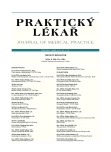Interstitial lung diseases in questions and answers
Authors:
M. Šterclová; M. Vašáková
Published in:
Prakt. Lék. 2011; 91(12): 707-709
Category:
Various Specialization
Overview
Due to the increasing incidence of interstitial lung diseases, patients with this type of lung involvement are more often seen at general practitioners’ surgeries. The following article highlights the important information from a patient’s history, which should be targeted during examination. The common symptoms of interstitial lung diseases are discussed.
After history assessment and clinical examination, the general practitioner should formulate a suspicion of lung disease. Patient should be referred to a respiratory specialist, who either confirms or rules out interstitial lung disease. Centres specializing in interstitial lung diseases provide a diagnostic program and suggest treatment possibilities.
Early diagnosis and treatment may significantly improve the prognosis of some patients. There has been no effective treatment of several interstitial lung diseases namely idiopathic pulmonary fibrosis. Prompt diagnosis may help to select candidates for lung transplantation, which may extend life and improve its quality in appropriate patients.
Key words:
interstitial lung diseases, idiopathic pulmonary fibrosis, dyspnoea, cough.
Sources
1. American Thoracic Society. American Thoracic Society/European Respiratory Society International Multidisciplinary Consensus Classification of the Idiopathic Interstitial Pneumonias. This joint statement of the American Thoracic Society (ATS), and the European Respiratory Society (ERS) was adopted by the ATS board of directors, June 2001 and by the ERS Executive Committee, June 2001. American Thoracic Society; European Respiratory Society. Am. J. Respir. Crit. Care Med. 2002, 2, p. 277-304.
2. Homolka, J. Pokroky v oblasti intersticiálních plicních procesů. Postgraduální medicína, 2006, 8, s. 652-656.
3. Jansa, P. Staré a nové pilíře v léčbě plicní arteriální hypertenze. Medicína po promoci, 2006, 7, s. 5-7.
4. Povýšil, C. Histopathological classification of idiopathic interstitial pneumonias. Cesk. Patol. 2010, 1, p. 3-7.
5. Raghu, G., Collard, H.R., Egan, J.J. et al. An official ATS/ERS/JRS/ALAT statement: idiopathic pulmonary fibrosis: evidence-based guidelines for diagnosis and management. Am. J. Respir. Crit. Care Med. 2011, 6, p. 788-824.
6. Ryu, J.H., Olson, E.J., Midthun, D.E., Swensen, S.J. Diagnostic approach to the patient with diffuse lung disease. Mayo Clin. Proc. 2002, 11, p. 1221-1227.
7. Šterclová, M., Vašáková, M. Exogenní alergická alveolitida. Popelka mezi intersticiálními plicními procesy? Prakt. Lék. 2007, 87, 8, s. 470-473.
8. Vašáková, M., Polák, J., Matěj, R. Intersticiální plicní procesy. Praha: Maxdorf, 2011. 410 s. ISBN 978-80-7345-251-3.
9. Vašáková, M., Kolek, V. Intersticiální plicní procesy. In Kolek, V., Kašák, V., Vašáková, M. a kol. Pneumologie. Praha: Maxdorf, 2011, s. 233-284.
8. Vašáková, M. Idiopatická plicní fibróza - Novinky v diagnostice a léčbě. Interní Medicína, 2007, 5, s. 233-236.
9. Vašáková, M., Šterclová, M., Anton, J. Intersticiální plicní procesy - přehled, diferenciální diagnostika, vyšetřovací metody. Prakt. Lék. 2007, 87, 8, s. 461-468.
10. Vašáková, M., Šterclová, M., Anton, J. Sarkoidóza - systémová nemoc. Co je nového? Prakt. Lék. 2008, 88, 4, s. 208-212.
Labels
General practitioner for children and adolescents General practitioner for adultsArticle was published in
General Practitioner

2011 Issue 12
Most read in this issue
- Ulcerogenic corticosteroids – the persisting myth among Czech doctors
- Classification of techniques to cope with craving
- Deficit Fluid Volume rating by nurses according to the diagnostic cues of nursing diagnosis
- Interstitial lung diseases in questions and answers
